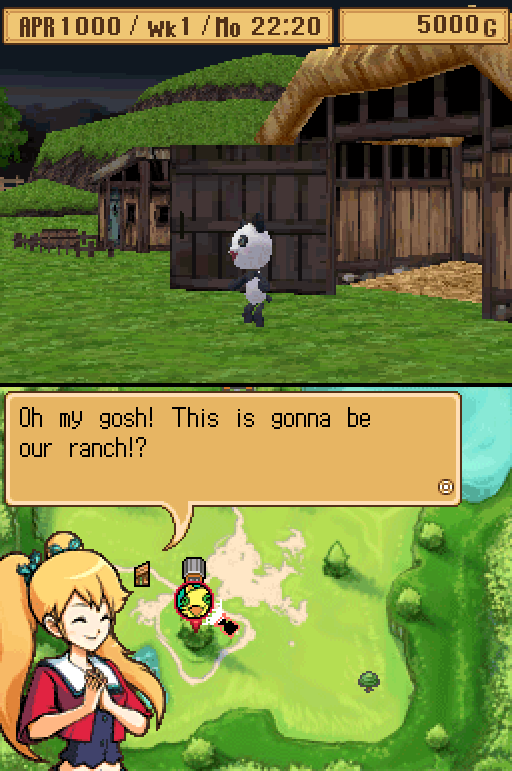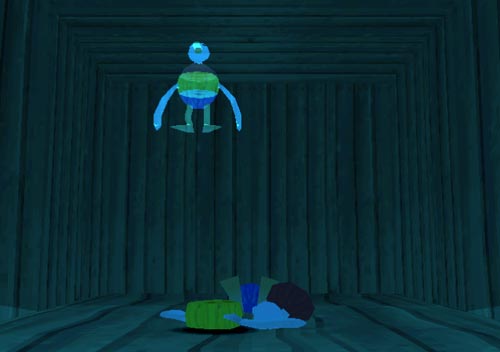The Monster Rancher series (Monster Farm in Japan) began life as a series of PlayStation video games, produced by TECMO. It had spinoffs such as Monster Rancher Battle Card Episode II for the Playstation, and other main titles on other systems such as Monster Rancher Advance for the GBA.
Monster Rancher as a series never caught on with casual gamers, as it's very hard, and the games were cult classics even when they were new. But it's very personal to me; my first exposure to it was watching my cousin play the first game when I was about 8. I don't have my own copy of the first game, but I spent an inordinate amount of time playing 2, the spinoffs, the GBA games, and the latest main installment, Monster Rancher DS. I have an assortment of memories attached to all of the games and while I was never good at them, save 3, DS, and Battle Card Episode II, they were a blast to play.
But the games, fun and nostalgic as they are, aren't going to be what my first thing to blog about is.
Around the time of the second game's release...there was a Monster Rancher anime. It ran for three seasons, though the third one was post-script and made after it was uncanceled; the third season is generally regarded as not as good, though it did feature some monsters the first two left out. For the purposes of this blog, I'll be covering the first two seasons.
Taking its monsters and general elements from the first two PlayStation games, as that's all there were at the time, the Monster Rancher anime was produced by TMS Entertainment, known for its high-quality animation. It ran on Fox Kids and the BKN Network from 1999 to 2001 and was dubbed by The Ocean Group of Mega Man and Dragonball Z fame.
And it was awesome.
But before we get into the anime itself, we should probably check out the games and what helped make the anime what it is--what did it use and what did it discard?
Looking at the series at a glance, one might compare it to Pokemon or Digimon--you, the player, raise Monsters and train them for tournaments. You're assisted by a female partner--the first game had Holly, and the second had Colt--who helps raise your monster and morale. Your ultimate goal is to defeat the strongest monster breeders around and become champion.
 |
| The shrine where dreams, and Monsters, are made! |
But it was the execution of the idea that made Monster Rancher so special. For one, you didn't catch monsters, nor did you recruit them. Instead, you used disk stones--CDs lying around your house--to unlock them in shrines; each one contained a unique monster. Note the a. One CD meant one specific monster. Not only could you use music CDs, you could also use computer CDs and even other PlayStation games.
Some specific CDs gave you special monsters that couldn't be found anywhere else, and they were usually very powerful--the game Brave Fencer Musashi, for instance, gave you a special Durahan monster named Shogun. Later installments also let you use PS2 games and DVDs, giving you even more of a chance to find a cool monster to raise.
There were two other ways to get monsters, as well--you could get a free one from the Market if you didn't have any CDs on hand, or you could combine two existing monsters into a new one in a process called fusing. Fusing was especially interesting as it could get you an entirely new monster depending on what types and subtypes they had--mixing a Mint (Pixie/Tiger) and a purebred Golem (Golem/Golem) could get you a Golem/Pixie, a Pixie/Golem, or even a Golem/Tiger. What order you fused them in also affected things, and it was a fun way to see your monsters' potential--or waste all your money and get a Game Over at the very start.
Some monsters aren't available at the start of the game; to unlock them you must fulfill certain requirements, such as finding an item on an exploration or raising certain monsters the right way. (I still can't get an Undine or Niton in MR2.)
 |
| From the LP Archive's Monster Rancher DS LP. |
Once you obtain your monster, it's time to head to the Ranch, and this is where the gameplay begins. First off, you feed your Monster once a month; which foods you can give him/her depend on which game you're playing. Once you've fed it, you can start training, because to put it bluntly, your monster's kind of weak. It's up to you to raise them properly to be strong--though if you train them too hard without resting, it has bad consequences. Balancing training and resting makes for a happier monster, and is important to gain stats properly.
Each Monster has 6 basic stats: LIF, POW, INT, SKI, SPD, and DEF.
 |
| The pre-battle screen, showing the monsters' stats. |
LIF is a measurement of your monster's Life, their HP. POW is for Power, which affects how strong their physical moves are and lessens damage taken from POW moves. INT is for Intelligence and affects how strong their INT moves are, as well as lessening the damage they take from INT moves. SKI is for Skill, which affects how accurate your monster's attacks are--a must-have for later battles. SPD is for Speed and affects your monster's dodge rate. DEF is for Defense, which lessens damage taken overall.
Of course, which stats your Monster excels in depends on what type it is and what kind of training you give it. Pixies, for example, don't do well with POW stat gains, while Golems aren't so hot at INT gains. Drills increase 1 or 2 stats at a time, with advanced drills sometimes decreasing stats.An errantry sends your monster on a course for an entire month, with the chance to not only increase stats but also learn new moves. Occasionally, you could also be approached to explore dangerous areas with a professor or archaeologist, where you could get rare items and fight wild monsters. Monster Rancher as a whole is pretty cerebral, especially earlier, harder installments. Unless you don't feel like playing by numbers. :P
 |
| The battle screen, showing the monsters' moves and GUTS. |
Once your monster's trained enough, you head to the tournaments. One monster would be pitted against the other. In battle, each attack costs GUTS to use. If you don't have enough for that particular move, you can't use it. Attacks either hit the monster or are dodged, depending on stats. Battle continues until one monster loses all their LIF or the timer runs out; if time runs out the one with the most LIF wins.
You can also choose whether to give your monster advice or let them fight on their own; either choice has advantages and disadvantages. Tournaments generally came in one of two styles--a tier-style tournament, or one where you fought all the monsters, and whoever won the most battles is declared the winner. In case of a tie, the monsters square off for a tie-breaker match.
So you train your monster and get them better stats and attacks to to win tournaments. Simple.
 |
| This Kato/Mocchi is particular about his food. |
But the major draw, I think, was the bond between you and your monster. Monsters are like people--they have favorite and least favorite foods, likes and dislikes, and change their reactions to you depending on how you raise them. If you're soft on them, they'll like you more, but they'll be spoiled and won't take training seriously. if you're harder on them, they'll focus more in fights, but may fear you and may not live as long. Balance is generally key, though I tended to be soft on my monsters--unless they cheated on drills, in which case they deserved that scolding. Gotta know WHEN to punish them. :P
 |
| Mine likes me. :3 |
 | |
| This image came from a Monster Rancher 2 LP on the LP Archive. He was just as sad as I was. :( |
But...nothing lasts forever. Eventually, your monsters can and will die, whether it be from old age, working without resting, or a powerful hit in battle. There are a couple things you can do before this happens; you can freeze your monster in a lab to stop it dying, then take it out for a tournament or somesuch, or freeze it and combine it later on with another monster so they live on in spirit. Or you could let it die, letting its accomplishments live on--and depending on what game you're playing, possibly gain a new monster from it. (Yes, they were cruel enough to have some species, like the Ghost, be gained upon death.)
Some games, such as 4, the Advance games, and EVO took out the death feature, instead having your monster grow too old to continue fighting and letting you retire it peacefully. (Monster Rancher DS, the most recent game in the series, brought death back.)
Whether death or retirement, the addition of limited time with your monster as a feature makes the time you do spend with them that much more personal. You treasure every moment you have with it, look for ways to help it get to S Rank and beyond before its time is up. You can even use an item glitch/exploit in 2 to increase its lifespan by a week repeatedly--not only can it win tournaments, but you can have your favorite, hard-raised monster around longer.
The Monster Rancher anime had a lot to choose from--cool CDs, complex game mechanics, battles and tournaments, how to make a story out of it, and the personal connections to monsters.
 |
| Genki unlocks a monster. |
In the anime, Monsters are unlocked from Mystery Disks at shrines. How and why this came about is revealed later on, and the overall feel of it is similar to the unlocking process from Monster Rancher 2. While the tournaments and training took a backseat--though they did come into play in season 3--the raising aspect was retained, especially in early episodes. And it definitely wasn't short on battles and learning; nearly every main monster learns a new attack at some point, and the battles are expertly animated and well done. Also, the humans fought alongside the monsters, showing that they could be battle-capable too.
Now for the story. Genki Sakura, a Monster Rancher champion, receives a special beta disk as a prize for winning a tournament. (Lest you think the show's too far removed from the games, the first episode essentially has him playing Monster Rancher 2, intro intact.) When he puts the disk into his console and starts playing, he finds himself magically transported to the Monster Rancher world--and it's a world that needs his help.
 |
| The starting gang of four |
But where the anime really shines is the personal connection. Across 48 episodes and 2 seasons, you bond with the humans and the monsters, cheer them on as they embark on an uphill battle, meet many friends and enemies, and grow as people. I feel better for having watched it, and I hope you will feel better for reading about it. I could go into more details about the personal connection but I think that will be explained in the story itself, and individual episodes.
And one last tidbit of awesome? Across all three seasons, every species of Monster from both games was seen except for the Doodle and living Disk.


Aaaaaaaaa
ReplyDeleteI actually remember watching this show! I think we have a GBA game somewhere!
The mem-ories! The MEM-ories are coming back! :DDD
:D Cool!
Delete